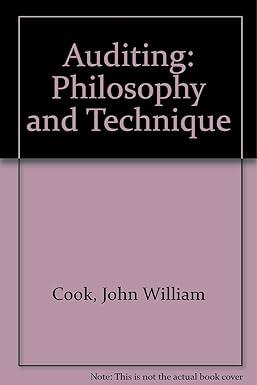Question
In May 2001, the Securities and Exchange Commission sued the former top executives at Sunbeam, charging the group with financial reporting fraud that allegedly cost
In May 2001, the Securities and Exchange Commission sued the former top executives at Sunbeam, charging the group with financial reporting fraud that allegedly cost investors billions in losses. Sunbeam Corporation is a recognized designer, manufacturer, and marketer of household and leisure products, including Coleman, Eastpak, First Alert, Grillmaster, Mixmaster, Mr. Coffee, Oster, Powermate, and Campingaz. In the mid-1990s, Sunbeam needed help: its profits had declined by over 80% percent, and in 1996, its stock price was down over 50% from its high. To the rescue: Albert Dunlap, also known as Chainsaw Al based on his reputation as a ruthless executive known for his ability to restructure and turn around troubled companies, largely by eliminating jobs. The strategy appeared to work. In 1997, Sunbeams revenues had risen by 18 percent. However, in April 1998, the brokerage firm of Paine Webber downgraded Sunbeams stock recommendation. Why the downgrade? Paine Webber had noticed unusually high accounts receivable, massive increases in sales of electric blankets in the third quarter 1997, which usually sell best in the fourth quarter, as well as unusually high sales of barbeque grills for the fourth quarter. Soon after, Sunbeam announced a first quarter loss of $44.6 million, and Sunbeams stock price fell 25 percent. It eventually came to light that Dunlap and Sunbeam had been using a bill-and-hold strategy with retail buyers. This involved selling products at large discounts to retailers before they normally would buy and then holding the products in third-party warehouses, with delivery at a later date. Many felt Sunbeam had deceived shareholders by artificially inflating earnings and the companys stock price. A class-action lawsuit followed, alleging that Sunbeam and Dunlap violated federal securities laws, suggesting the motivation to inflate the earnings and stock price was to allow Sunbeam to complete hundreds of millions of dollars of debt financing in order to complete some ongoing mergers. Shareholders alleged damages when Sunbeams subsequent earnings decline caused a huge drop in the stock price. Required: How might Sunbeams 1997 bill-and-hold strategy have contributed to artificially high earnings in 1997? How would the strategy have led to the unusually high accounts receivable Paine Webber noticed? How might Sunbeams 1997 bill-and-hold strategy have contributed to a 1998 earnings decline? How does earnings management of this type affect earnings quality? In a 57 double-spaced, typed paper, provide complete answers to the questions at the end of the case, fully explaining your answer with cited support. In addition, discuss the ethical issues that surround the parties involved and their actions. Please note the expectation: this assignment is a paper, not simple replies to the case questions. The submitted paper should include an introduction, body, conclusion, and references page. APA style and formatting should be applied to citations and references.
Step by Step Solution
There are 3 Steps involved in it
Step: 1

Get Instant Access to Expert-Tailored Solutions
See step-by-step solutions with expert insights and AI powered tools for academic success
Step: 2

Step: 3

Ace Your Homework with AI
Get the answers you need in no time with our AI-driven, step-by-step assistance
Get Started


